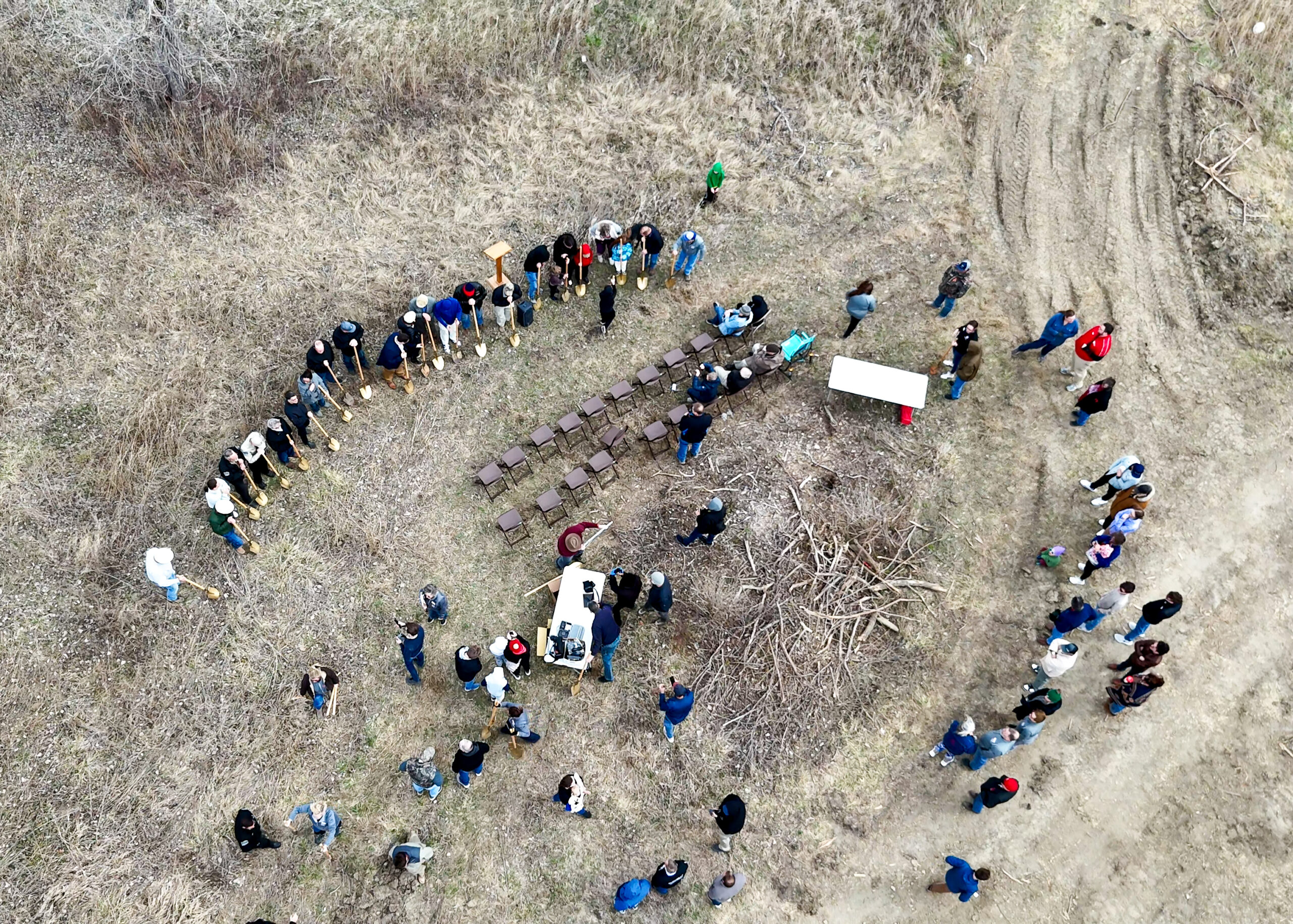Recently, Thrive Allen County Executive Director David Toland traveled to Great Bend, Kansas to meet with leaders in Barton County and discuss our work in Allen County.
Reprinted, with permission, from the Great Bend Tribune:
A healthy approach
Thrive exec Toland shares similarities between Allen and Barton counties
Be Well Barton County welcomed David Toland, executive director of Thrive Allen County, to a special meeting Tuesday that included several community leaders from Great Bend, Hoisington and Ellinwood.
Toland talked about projects Thrive had undertaken in the past four years in Iola and other small towns in Allen County to increase the health of its citizens. Through built environment projects and other health initiatives, Allen County has gone from being ranked 94 of 105 Kansas counties for health to a rank of 79 in just five years.
“Our goal is to become the healthiest rural county in Kansas. Period,” he said.
The built environment of a community is defined as the human-made space used for human activity. It can include buildings and parks or green space as well as infrastructure.
In 2008 Allen County reported on the state of community well being and recreation opportunities. Declining population, double-digit poverty overall, but especially high for children, lower than average wages, poor health rankings, low participation in recreation activities, Toland began by comparing vital statistics between Allen County and Barton County. The two counties were very similar, albeit Barton county had a larger population, a higher median income, and more resources at its disposal.
Barton County, too is ahead of Allen County, ranked the 68th healthiest county in Kansas. This underscored the point Toland made, that improvements for Barton County, like Allen County, are very doable. Then, he drilled deeper.
Improving access to health care
Five years ago, Allen County was in severe need of dentists and doctors. A high number of the children of the county lived in poverty, with little or no reasonable access to health care. This was identified as one of the top goals, and Thrive went to work recruiting these health professionals. It wasn’t easy, Toland said.
“We could wine and dine the practitioners, but when the wives and children came to visit, by Monday morning, the candidate would be calling, thanking us for our hospitality, but turning down the offer,” he said. “We realized we needed to work on making our small town appealing to not just professionals, but their families too.”
Members of Thrive went to work, learning what would entice people from outside their towns to decide Iola and other Allen County towns would be a good place to live. What they found was people wanted bike trails, bike lanes, dog parks, schools their kids could walk to, and access to health care. Lack of any of these could be real deal breakers.
“Small towns won’t survive if people don’t want to live there,” he said. For many years, Iola lost residents to nearby Chanute. They would live there, and drive to jobs in Iola, and every year, Iola lost more people.
To turn that around, Thrive began working on projects to not only improve the image of their small town, but to promote healthy life styles, recognizing that their focus couldn’t just be on recruiting from outside. They also had to consider the residents they already had.
A community garden was a highly visible, quick win project Iola undertook. All that was needed was a piece of land, water, and someone willing to plow up the plots. Later, the gardens expanded to include more plots and raised beds to accommodate gardeners confined to wheel chairs and those who stooping was a problem.
But inexpensive quick-fix projects weren’t enough. Changes were needed to infrastructure. The county was in need of a modern hospital. It was important to make sure no small town in the county was left out of the conversation, Toland said. “Passing a bond initiative is a lot easier if you have everyone on board,” he said.
Thrive went to each town, meeting in community buildings and living rooms to talk with people and find out what their needs were. Then, they helped where they could, and where they couldn’t, they got the word out to those who could have an impact. Through efforts like these, Thrive was able to bring about collaboration between many groups which resulted in the county taking back its hospital from a private company and building a modern facility.
In addition to new doctors, dentists have come to Allen County. By focusing on oral health initiatives, in four years the county reduced by 34 percent the prevalence of oral decay among its children.
This point resounded with County Commissioner Melissa Straub. Ellinwood could really use a dentist, she said, something the town hasn’t had since their last dentist retired.
Cool quotient
Thrive also realized the county needed a grant writer who could access the funds needed for the many projects groups in the community were inspired to take on. Now, if a small town wants to install a garden or a trail, the grant writer finds the money, and the people go to work creating their vision.
“It’s about sprinkling a lot of seeds out there and seeing what grows,” Toland said.
Iola has rebranded itself to reflect the kind of town it aspires to become. He displayed new logos that reflect the buildings in town, bicyclists and runners, cleanliness and tidiness. He stressed the process of branding should not be rushed, and even if there are qualified people in town to create branding materials, corners should not be cut during this process.
They also created a 5K run with a unique hook. The Charley Melvin Mad Bomber Run For Your Life, held after midnight in the middle of July, used a notorious bit of local history to draw runners in (https://madbomberrun.com/). The turnout was amazing, with more than 1,000 runners participating. This, for a town of about 5,700.
Again, it took very little money, and helped people in the area begin change the way people thought about themselves and their community, Toland said.
One project, however, that was tough to pass was an initiative to install a dog park in Iola. After the majority of doctor and dentist candidates inquired about the existence of a dog park, Toland said the committee decided to work on getting one. But many residents didn’t see the need. It took a lot of convincing to finally get the support needed, but now it is a popular feature at the city park.
“We aren’t where we want to be yet, but we’re making marked improvements,” he said.
Recently, when Thrive was unable to get funding to make sidewalk improvements, the Iola City Council approved the installation of a half-mile of sidewalk to be installed out to the Walmart at the far edge of town.
“A city council person brought the suggestion to the committee after seeing a man in a motorized wheel chair trying to make his way along a multi-lane highway to the store,” Toland said. Awareness was increasing, and elected officials and business people have begun to take initiatives on their own.
Closer to home
Sue Cooper, a member of Be Well Barton County’s board and the facilitator for the meeting, asked attendees what projects Toland had highlighted spoke to them. After a few moments, County Administrator Richard Boeckman said he would like to see improvements to access to the bike route along the flood control south and west of Great Bend. He’s also like to see safer biking opportunities between Ellinwood and Great Bend, as well as a bike path between Great Bend and Barton Community College.
“I think it would get tremendous use,” he said.
Mary Hoisington, publisher of the Great Bend Tribune and a member of several community boards, wondered aloud about the possibilities of installing new sidewalks and improving existing sidewalks to make access to the city’s parochial schools safer for students and access to the Great Bend retail corridor more accessible by walkers.
City administrator Howard Partington responded that while the installation and maintenance of sidewalks is the responsibility of property owners, the city does provide a 20 percent match of funds. However, it is not a function of the city to act as the contractor on these projects. He said very few residents ever take advantage of the match, so much so that the money set aside for the purpose is never completely used.
Toland said while the Sunflower Foundation doesn’t provide funding for sidewalks, it does provide funding for trails, which by definition must be six feet wide. He suggested that options existed to increase connectivity to the flood control bike path this way.
He also provided a little history lesson. While Great Bend is not unusual in its sidewalks policy from other Midwest cities, other parts of the country see things differently. “On the east coast, sidewalks have always been seen as transportation infrastructure and are the city’s responsibility,” Toland said. “Just like the roads.”
Thank you to Be Well Barton County for hosting this important community discussion!




